Shop for Plans
Shop for your own coverage
Plans through your employer
Learn about the medical, dental, pharmacy, behavioral, and voluntary benefits your employer may offer.
Learn
Looking for Medicare coverage?
Childhood Hodgkin Lymphoma Treatment (PDQ®): Treatment - Patient Information [NCI]
General Information About Childhood Hodgkin Lymphoma
Childhood Hodgkin lymphoma is a cancer that develops in the lymph system.
The lymph system is part of the immune system. It helps protect the body from infection and disease.
The lymph system is made up of the following:
- Lymph: Colorless, watery fluid that travels through the lymph vessels and transports T and B lymphocytes. Lymphocytes are a type of white blood cell.
- Lymph vessels: A network of thin tubes that collect lymph from different parts of the body and return it to the bloodstream.
- Lymph nodes: Small, bean-shaped structures that filter lymph and store white blood cells that help fight infection and disease. Lymph nodes are found along a network of lymph vessels throughout the body. Groups of lymph nodes are found in the neck, underarm, mediastinum (the area between the lungs), abdomen, pelvis, and groin. Hodgkin lymphoma most commonly forms in the lymph nodes above the diaphragm.
- Spleen: An organ that makes lymphocytes, stores red blood cells and lymphocytes, filters the blood, and destroys old blood cells. The spleen is on the left side of the abdomen near the stomach.
- Thymus: An organ in which T lymphocytes mature and multiply. The thymus is in the chest behind the breastbone.
- Bone marrow: The soft, spongy tissue in the center of certain bones, such as the hip bone and breastbone. White blood cells, red blood cells, and platelets are made in the bone marrow.
- Tonsils: Two small masses of lymph tissue at the back of the throat. There is one tonsil on each side of the throat.
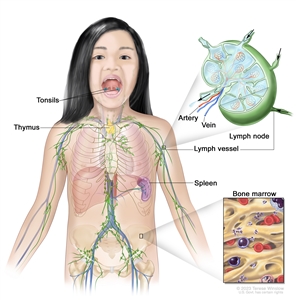
The lymph system is part of the body's immune system and is made up of tissues and organs that help protect the body from infection and disease. These include the tonsils, thymus, spleen, bone marrow, lymph vessels, and lymph nodes. Lymph (clear, watery fluid) and lymphocytes (white blood cells) travel through the lymph vessels and into the lymph nodes where the lymphocytes destroy harmful substances. The lymph enters the bloodstream through a large vein near the heart.
Bits of lymph tissue are also found in other parts of the body such as the lining of the gastrointestinal tract, bronchus, and skin.
There are two general types of lymphoma: Hodgkin lymphoma and non-Hodgkin lymphoma. This summary is about the treatment of childhood Hodgkin lymphoma.
Hodgkin lymphoma occurs most often in adolescents 15 to 19 years of age. The treatment for children and adolescents is different than treatment for adults.
Other PDQ summaries with information related to lymphoma include the following:
-
Childhood Non-Hodgkin Lymphoma Treatment -
Hodgkin Lymphoma Treatment
The two main types of childhood Hodgkin lymphoma are classic and nodular lymphocyte-predominant.
- Classic Hodgkin lymphoma is the most common type of Hodgkin lymphoma. It occurs most often in adolescents. When a sample of lymph node tissue is looked at under a microscope, Hodgkin lymphoma cancer cells, called Reed-Sternberg cells, may be seen.

Reed-Sternberg cell. Reed-Sternberg cells are large, abnormal lymphocytes (a type of white blood cell) that may contain more than one nucleus. These cells are found in people with Hodgkin lymphoma. Reed-Sternberg cells are also called Hodgkin and Reed-Sternberg cells.Classic Hodgkin lymphoma is divided into four subtypes, based on how the cancer cells look under a microscope:
- Nodular-sclerosing Hodgkin lymphoma occurs most often in older children and adolescents. It is common to have a chest mass at diagnosis.
- Mixed cellularity Hodgkin lymphoma most often occurs in children younger than 10 years of age. It is linked to a history of Epstein-Barr virus (EBV) infection and often occurs in the lymph nodes of the neck.
- Lymphocyte-rich Hodgkin lymphoma is rare in children. When a sample of lymph node tissue is looked at under a microscope, there are Reed-Sternberg cells and many normal lymphocytes and other blood cells.
- Lymphocyte-depleted Hodgkin lymphoma is rare in children and occurs most often in adults or adults with HIV. When a sample of lymph node tissue is looked at under a microscope, there are many large, oddly shaped cancer cells and few normal lymphocytes and other blood cells.
- Nodular lymphocyte-predominant Hodgkin lymphoma is less common than classic Hodgkin lymphoma. It most often occurs in children younger than 10 years of age. Nodular lymphocyte-predominant Hodgkin lymphoma often occurs as a swollen lymph node in the neck, underarm, or groin. Most individuals do not have any other signs or symptoms of cancer at diagnosis. When a sample of lymph node tissue is looked at under a microscope, the cancer cells are shaped like popcorn.
Epstein-Barr virus infection and a family history of Hodgkin lymphoma can increase the risk of childhood Hodgkin lymphoma.
Anything that increases a person's chance of getting a disease is called a risk factor. Not every person with one or more of these risk factors will develop childhood Hodgkin lymphoma, and it can develop in some children who don't have any known risk factors. Talk with your child's doctor if you think your child may be at risk.
Risk factors for childhood Hodgkin lymphoma include the following:
- being infected with the Epstein-Barr virus (EBV)
- being infected with HIV
- having certain diseases of the immune system, such as autoimmune lymphoproliferative syndrome
- having a weakened immune system after an organ transplant or from medicine given after a transplant to stop the organ from being rejected by the body
- having a parent, brother, or sister with a personal history of Hodgkin lymphoma
Inherited changes in genes may increase the risk of childhood Hodgkin lymphoma.
Being exposed to common infections in early childhood may decrease the risk of Hodgkin lymphoma in children.
Signs of childhood Hodgkin lymphoma include swollen lymph nodes, fever, drenching night sweats, and weight loss.
The signs and symptoms of Hodgkin lymphoma depend on where the cancer forms in the body and the size of the cancer. It's important to check with your child's doctor if your child has any symptoms below:
- painless, swollen lymph nodes near the collarbone or in the neck, chest, underarm, or groin
- fever for no known reason
- weight loss for no known reason
- drenching night sweats
- feeling very tired
- anorexia
- itchy skin
- coughing
- trouble breathing, especially when lying down
- pain in the lymph nodes after drinking alcohol
Fever for no known reason, weight loss for no known reason, or drenching night sweats are called B symptoms. B symptoms are an important part of staging Hodgkin lymphoma and understanding the patient's chance of recovery.
These symptoms may be caused by conditions other than childhood Hodgkin lymphoma. The only way to know is to see your child's doctor. The doctor will ask you when the symptoms started and how often your child has been having them as a first step in making a diagnosis.
Tests that examine the lymph system and other parts of the body are used to diagnose and stage childhood Hodgkin lymphoma.
If your child has symptoms that suggest Hodgkin lymphoma, their doctor will need to find out if these are due to cancer or to another condition. They will ask about your child's personal and family health history and do a physical exam. The doctor may recommend diagnostic tests to find out if your child has Hodgkin lymphoma. The results of these tests will also help you and your child's doctor plan treatment.
The following tests and procedures may be used:
- Complete blood count (CBC): A procedure in which a sample of blood is drawn and checked for the following:
- The number of red blood cells, white blood cells, and platelets.
- The amount of hemoglobin (the protein that carries oxygen) in the red blood cells.
- The portion of the blood sample made up of red blood cells.
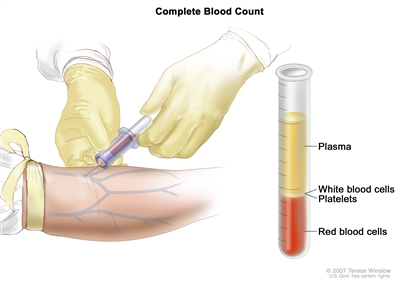
Complete blood count (CBC). Blood is collected by inserting a needle into a vein and allowing the blood to flow into a tube. The blood sample is sent to the laboratory and the red blood cells, white blood cells, and platelets are counted. The CBC is used to test for, diagnose, and monitor many different conditions.
- Blood chemistry studies: A procedure in which a blood sample is checked to measure the amounts of certain substances released into the blood, including albumin, by organs and tissues in the body. An unusual (higher or lower than normal) amount of a substance can be a sign of disease.
- C-reactive protein test: A test in which a blood sample is checked to measure the amount of c-reactive protein in the blood. C-reactive protein is made by the liver and sent to the bloodstream in response to inflammation. A higher-than-normal amount of c-reactive protein in the blood may be a sign of disease.
- Sedimentation rate: A procedure in which a sample of blood is drawn and checked for the rate at which the red blood cells settle to the bottom of the test tube. The sedimentation rate is a measure of how much inflammation is in the body. A higher-than-normal sedimentation rate may be a sign of lymphoma. Also called erythrocyte sedimentation rate, sed rate, or ESR.
- CT scan (CAT scan): A procedure that makes a series of detailed pictures of areas inside the body, such as the neck, chest, abdomen, or pelvis, taken from different angles. The pictures are made by a computer linked to an x-ray machine. A dye may be injected into a vein or swallowed to help the organs or tissues show up more clearly. This procedure is also called computed tomography, computerized tomography, or computerized axial tomography. To learn more, see
Computed Tomography (CT) Scans and Cancer .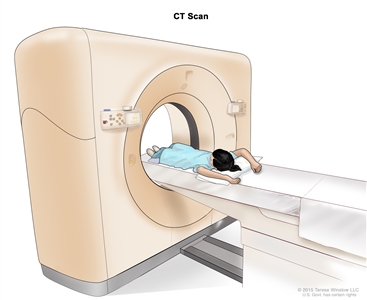
Computed tomography (CT) scan. The child lies on a table that slides through the CT scanner, which takes a series of detailed x-ray pictures of areas inside the body. - PET scan (positron emission tomography scan): A procedure to find malignant tumor cells in the body. A small amount of radioactive glucose (sugar) is injected into a vein. The PET scanner rotates around the body and makes a picture of where glucose is being used in the body. Malignant tumor cells show up brighter in the picture because they are more active and take up more glucose than normal cells do.

Positron emission tomography (PET) scan. The child lies on a table that slides through the PET scanner. The head rest and white strap help the child lie still. A small amount of radioactive glucose (sugar) is injected into the child's vein, and a scanner makes a picture of where the glucose is being used in the body. Cancer cells show up brighter in the picture because they take up more glucose than normal cells do. - MRI (magnetic resonance imaging): A procedure that uses a magnet, radio waves, and a computer to make a series of detailed pictures of areas inside the body, such as the lymph nodes. This procedure is also called nuclear magnetic resonance imaging (NMRI).
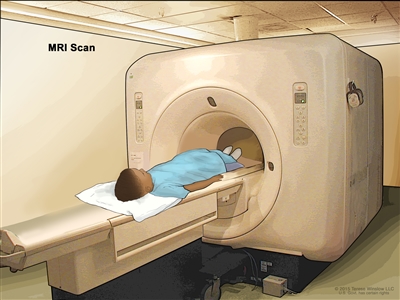
Magnetic resonance imaging (MRI) scan. The child lies on a table that slides into the MRI machine, which takes a series of detailed pictures of areas inside the body. The positioning of the child on the table depends on the part of the body being imaged. - PET-CT scan: A procedure that combines the pictures from a positron emission tomography (PET) scan and a computed tomography (CT) scan. The PET and CT scans are done at the same time with the same machine. The combined scans give more detailed pictures of areas inside the body than either scan gives by itself.
- PET-MRI scan: A procedure that combines the pictures from a positron emission tomography (PET) scan and a magnetic resonance imaging (MRI) scan. A PET scan uses a radioactive tracer to highlight abnormal areas in the body. An MRI uses radio waves and a powerful magnet to take detailed pictures of tissues in the body. For a PET-MRI, the scans are done at the same time with the same machine. The combined scans give more detailed pictures of areas inside the body than either scan gives by itself. The overall amount of radiation a person is exposed to is also reduced. A PET-MRI may be used to help diagnose disease, such as cancer, plan treatment, or find out how well treatment is working.
- Chest x-ray: An x-ray of the organs and bones inside the chest. An x-ray is a type of energy beam that can go through the body and onto film, making a picture of areas inside the body.
- Bone marrow aspiration and biopsy: The removal of bone marrow and a small piece of bone by inserting a hollow needle into the hipbone or breastbone. A pathologist views the bone marrow and bone under a microscope to look for abnormal cells. Bone marrow aspiration and biopsy is done for patients with advanced disease and/or B symptoms.

Bone marrow aspiration and biopsy. After a small area of skin is numbed, a bone marrow needle is inserted into the child's hip bone. Samples of blood, bone, and bone marrow are removed for examination under a microscope. - Lymph node biopsy: The removal of all or part of one or more lymph nodes. The lymph node may be removed during an image-guided CT scan or a thoracoscopy, mediastinoscopy, or laparoscopy. One of the following types of biopsies may be done:
- Excisional biopsy: The removal of an entire lymph node.
- Incisional biopsy: The removal of part of a lymph node.
- Core biopsy: The removal of tissue from a lymph node using a wide needle.
A pathologist views the lymph node tissue under a microscope to check for cancer cells called Reed-Sternberg cells. Reed-Sternberg cells are common in classic Hodgkin lymphoma.
The following test may be done on tissue that was removed:
- Immunophenotyping: A laboratory test that uses antibodies to identify cancer cells based on the types of antigens or markers on the surface of the cells. This test is used to help diagnose specific types of lymphoma.
You may want to get a second opinion.
You may want to get a second opinion to confirm your child's diagnosis and treatment plan. If you seek a second opinion, you will need to get important medical test results from the first doctor to share with the second doctor. The second doctor will review the pathology report, slides, and scans before giving a recommendation. They may agree with the first doctor, suggest changes or another approach, or provide more information about your child's cancer.
To learn more about choosing a doctor and getting a second opinion, see
Certain factors affect prognosis (chance of recovery) and treatment options.
If your child has been diagnosed with Hodgkin lymphoma, you may have questions about how serious the cancer is and your child's chances of survival. The likely outcome or course of a disease is called prognosis. The prognosis and treatment options depend on the following:
- the stage of the cancer (the size of the cancer and whether the cancer has spread below the diaphragm or to more than one group of lymph nodes)
- the size of the tumor
- whether there are B symptoms (fever for no known reason, weight loss for no known reason, or drenching night sweats) at diagnosis
- the type of Hodgkin lymphoma
- having more than the usual number of white blood cells or anemia at the time of diagnosis
- whether there is fluid around the heart or lungs at diagnosis
- the sedimentation rate or the albumin level in the blood
- how well the cancer responds to initial treatment with chemotherapy
- the child's sex
- whether the cancer is newly diagnosed or has recurred (come back)
The treatment options also depend on:
- whether there is a low, medium, or high risk the cancer will come back after treatment
- the child's age
- the risk of long-term side effects
Most children and adolescents with newly diagnosed Hodgkin lymphoma can be cured.
Your child's cancer care team is in the best position to talk with you about your child's prognosis.
Stages of Childhood Hodgkin Lymphoma
After childhood Hodgkin lymphoma has been diagnosed, tests are done to find out if cancer cells have spread within the lymph system or to other parts of the body.
The process used to find out if cancer has spread is called staging. The information gathered from the staging process determines the stage of the disease. The results of the
There are three ways that cancer spreads in the body.
Cancer can spread through tissue, the lymph system, and the blood:
- Tissue. The cancer spreads from where it began by growing into nearby areas.
- Lymph system. The cancer spreads from where it began by getting into the lymph system. The cancer travels through the lymph vessels to other parts of the body.
- Blood. The cancer spreads from where it began by getting into the blood. The cancer travels through the blood vessels to other parts of the body.
The following stages are used for childhood Hodgkin lymphoma:
Stage I

Stage I childhood Hodgkin lymphoma. Cancer is found in one or more lymph nodes in a group of lymph nodes or, in rare cases, cancer is found in the Waldeyer's ring, thymus, or spleen. In stage IE (not shown), cancer has spread to one area outside the lymph system.
Stage I is divided into stage I and stage IE.
- Stage I: Cancer is found in one of the following places in the lymph system:
- One or more lymph nodes in one lymph node group.
- Waldeyer's ring.
- Thymus.
- Spleen.
- Stage IE: Cancer is found outside the lymph system in one organ or area.
Stage II
Stage II is divided into stage II and stage IIE.
- Stage II: Cancer is found in two or more lymph node groups either above or below the diaphragm (the thin muscle below the lungs that helps breathing and separates the chest from the abdomen).
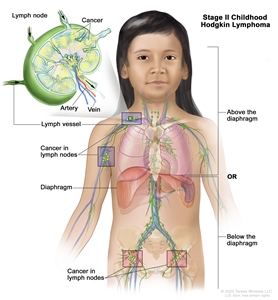
Stage II childhood Hodgkin lymphoma. Cancer is found in two or more lymph node groups that are either above the diaphragm or below the diaphragm. - Stage IIE: Cancer has spread from a group of lymph nodes to a nearby organ that is outside the lymph system. Cancer may have spread to other lymph node groups on the same side of the diaphragm.
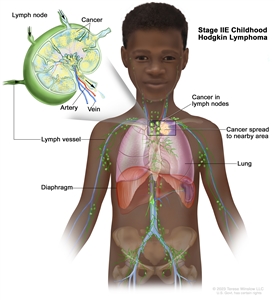
Stage IIE childhood Hodgkin lymphoma. Cancer has spread from a group of lymph nodes to a nearby organ or area that is outside the lymph system.
Stage III
In stage III, the cancer is found:
- in lymph node groups above and below the diaphragm (the thin muscle below the lungs that helps breathing and separates the chest from the abdomen); or
- in lymph node groups above the diaphragm and in the spleen.
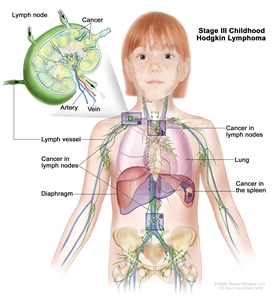
Stage III childhood Hodgkin lymphoma. Cancer is found (a) in lymph node groups above and below the diaphragm; or (b) in lymph node groups above the diaphragm and in the spleen.
Stage IV
In stage IV, the cancer:
- has spread throughout one or more organs outside the lymph system and may be in lymph nodes near those organs; or
- is found in two or more groups of lymph nodes that are on the same side of the diaphragm (the thin muscle below the lungs that helps breathing and separates the chest from the abdomen) and in an organ that is outside the lymph system and not near the affected lymph nodes; or
- is found in groups of lymph nodes on both side of the diaphragm and in any organ that is outside the lymph system; or
- has spread to the lungs, liver, or bone marrow from areas far away.
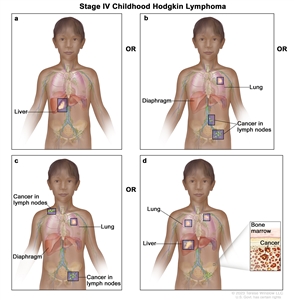
Stage IV childhood Hodgkin lymphoma. Cancer (a) has spread throughout one or more organs outside the lymph system, such as the liver; or (b) is found in two or more groups of lymph nodes that are on the same side of the diaphragm and in an organ that is outside the lymph system, such as the lung, and not near the affected lymph nodes; or (c) is found in groups of lymph nodes on both sides of the diaphragm and in any organ that is outside the lymph system, such as the lung; or (d) has spread to the lungs, liver, or bone marrow from areas far away.
In addition to the stage number, the letters A, B, E, or S may be noted.
The letters A, B, E, or S may be used to further describe the stage of childhood Hodgkin lymphoma.
- A: The patient does not have B symptoms (fever, weight loss, or drenching night sweats).
- B: The patient has B symptoms.
- E: Cancer is found in an organ or tissue that is not part of the lymph system but which may be next to an area of the lymph system affected by the cancer.
- S: Cancer is found in the spleen.
Childhood Hodgkin lymphoma is treated according to risk groups.
Untreated childhood Hodgkin lymphoma is divided into risk groups based on the stage, size of the tumor, and whether the patient has B symptoms (fever, weight loss, or drenching night sweats). The risk group describes the likelihood that Hodgkin lymphoma will not respond to treatment or recur (come back) after treatment. It is used to plan initial treatment.
-
Low-risk childhood Hodgkin lymphoma . -
Intermediate-risk childhood Hodgkin lymphoma . -
High-risk childhood Hodgkin lymphoma .
Low-risk Hodgkin lymphoma requires fewer cycles of treatment, fewer anticancer drugs, and lower doses of anticancer drugs than high-risk lymphoma.
Sometimes childhood Hodgkin lymphoma does not respond to treatment or comes back after treatment.
Primary refractory Hodgkin lymphoma is cancer that does not respond to initial treatment.
Recurrent Hodgkin lymphoma is cancer that has recurred (come back) after it has been treated. The lymphoma may come back in the lymph system or in other parts of the body, such as the lungs, liver, bones, or bone marrow.
Treatment Option Overview
There are different types of treatment for children with Hodgkin lymphoma.
There are different types of treatment for children with Hodgkin lymphoma. You and your child's care team will work together to decide treatment. Many factors will be considered, such as your child's overall health, and whether the tumor is newly diagnosed or has come back.
Children with Hodgkin lymphoma should have their treatment planned by a team of health care providers who are experts in treating childhood cancer.
A pediatric oncologist, a doctor who specializes in treating children with cancer, will oversee treatment of childhood Hodgkin lymphoma. The pediatric oncologist works with other pediatric health care providers who are experts in treating children with Hodgkin lymphoma and who specialize in certain areas of medicine. These may include the following specialists and others:
- pediatrician
- medical oncologist /hematologist
- radiation oncologist
- pathologist
- pediatric nurse specialist
- psychologist
- social worker
- child-life specialist
- fertility specialist
The treatment of Hodgkin lymphoma in adolescents and young adults may be different than the treatment for children. Some adolescents and young adults are treated with an adult treatment regimen.
The following types of treatment may be used:
Chemotherapy
Chemotherapy is a cancer treatment that uses one or more drugs to stop the growth of cancer cells, either by killing the cells or by stopping them from dividing. Cancer treatment using more than one chemotherapy drug is called combination chemotherapy. When chemotherapy is taken by mouth or injected into a vein or muscle, the drugs enter the bloodstream and can reach cancer cells throughout the body (systemic chemotherapy).
The way the chemotherapy is given depends on the risk group. For example, children with low-risk Hodgkin lymphoma receive fewer cycles of treatment, fewer anticancer drugs, and lower doses of anticancer drugs than children with high-risk lymphoma.
For more information, see
Radiation therapy
Radiation therapy is a cancer treatment that uses high-energy x-rays or other types of radiation to kill cancer cells or keep them from growing. External radiation therapy uses a machine outside the body to send radiation toward the area of the body with cancer.
Certain ways of giving radiation therapy can help keep radiation from damaging nearby healthy tissue. These types of external radiation therapy include the following:
- Conformal radiation therapy is a type of external radiation therapy that uses a computer to make a 3-dimensional (3-D) picture of the tumor and shapes the radiation beams to fit the tumor.
- Intensity-modulated radiation therapy (IMRT) is a type of 3-dimensional (3-D) radiation therapy that uses a computer to make pictures of the size and shape of the tumor. Thin beams of radiation of different intensities (strengths) are aimed at the tumor from many angles.
Radiation therapy may be given, based on the child's risk group and chemotherapy regimen. The radiation is given only to the lymph nodes or other areas with cancer.
Targeted therapy
Targeted therapy is a type of treatment that uses drugs or other substances to identify and attack specific cancer cells. Types of targeted therapy include the following:
- Monoclonal antibody therapy: Monoclonal antibodies are immune system proteins made in the laboratory to treat many diseases, including cancer. As a cancer treatment, these antibodies can attach to a specific target on cancer cells or other cells that may help cancer cells grow. The antibodies are able to then kill the cancer cells, block their growth, or keep them from spreading. Monoclonal antibodies are given by infusion. They may be used alone or to carry drugs, toxins, or radioactive material directly to cancer cells.
Rituximab or brentuximab may be used to treat high-risk, refractory, or recurrent childhood Hodgkin lymphoma.
monoclonal antibodies: how monoclonal antibodies treat cancerHow do monoclonal antibodies work to treat cancer? This video shows how monoclonal antibodies, such as trastuzumab, pembrolizumab, and rituximab, block molecules cancer cells need to grow, flag cancer cells for destruction by the body's immune system, or deliver harmful substances to cancer cells.
- Proteasome inhibitor therapy blocks the action of proteasomes in cancer cells. Proteasomes remove proteins no longer needed by the cell. When the proteasomes are blocked, the proteins build up in the cell and may cause the cancer cell to die.
Bortezomib is a proteasome inhibitor used to treat refractory or recurrent childhood Hodgkin lymphoma.
To learn more, see
Immunotherapy
Immunotherapy uses the patient's immune system to fight cancer. Substances made by the body or made in a laboratory are used to boost, direct, or restore the body's natural defenses against cancer. Types of immunotherapy include the following:
- Immune checkpoint inhibitor therapy: Some types of immune cells, such as T cells, and some cancer cells have certain proteins, called checkpoint proteins, on their surface that keep immune responses in check. When cancer cells have large amounts of these proteins, they will not be attacked and killed by T cells. Immune checkpoint inhibitors block these proteins, and the ability of T cells to kill cancer cells is increased. The following is a type of immune checkpoint inhibitor therapy:
- PD-1 and PD-L1 inhibitor therapy: PD-1 is a protein on the surface of T cells that helps keep the body's immune responses in check. PD-L1 is a protein found on some types of cancer cells. When PD-1 attaches to PD-L1, it stops the T cell from killing the cancer cell. PD-1 and PD-L1 inhibitors keep PD-1 and PD-L1 proteins from attaching to each other. This allows the T cells to kill cancer cells.
Pembrolizumab and nivolumab are types of PD-1 inhibitors that may be used in the treatment of childhood Hodgkin lymphoma that has come back after treatment. Nivolumab is being studied to treat high-risk childhood Hodgkin lymphoma.
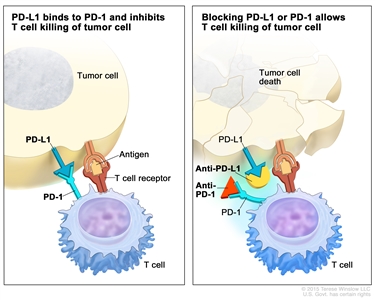
Immune checkpoint inhibitor. Checkpoint proteins, such as PD-L1 on tumor cells and PD-1 on T cells, help keep immune responses in check. The binding of PD-L1 to PD-1 keeps T cells from killing tumor cells in the body (left panel). Blocking the binding of PD-L1 to PD-1 with an immune checkpoint inhibitor (anti-PD-L1 or anti-PD-1) allows the T cells to kill tumor cells (right panel). immune checkpoint inhibitorsImmunotherapy uses the body's immune system to fight cancer. This animation explains one type of immunotherapy that uses immune checkpoint inhibitors to treat cancer. - PD-1 and PD-L1 inhibitor therapy: PD-1 is a protein on the surface of T cells that helps keep the body's immune responses in check. PD-L1 is a protein found on some types of cancer cells. When PD-1 attaches to PD-L1, it stops the T cell from killing the cancer cell. PD-1 and PD-L1 inhibitors keep PD-1 and PD-L1 proteins from attaching to each other. This allows the T cells to kill cancer cells.
- CAR T-cell therapy changes the patient's T cells (a type of immune system cell) so they will attack certain proteins on the surface of cancer cells. T cells are taken from the patient and special receptors are added to their surface in the laboratory. The changed cells are called chimeric antigen receptor (CAR) T cells. The CAR T cells are grown in the laboratory and given to the patient by infusion. The CAR T cells multiply in the patient's blood and attack cancer cells. CAR T-cell therapy is being studied to treat refractory or recurrent childhood Hodgkin lymphoma.
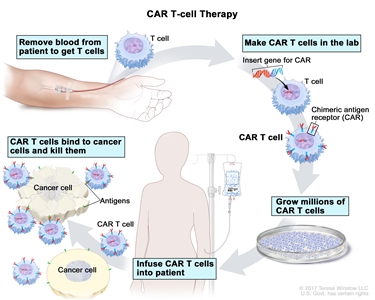
CAR T-cell therapy. A type of treatment in which a patient's T cells (a type of immune cell) are changed in the laboratory so they will bind to cancer cells and kill them. Blood from a vein in the patient's arm flows through a tube to an apheresis machine (not shown), which removes the white blood cells, including the T cells, and sends the rest of the blood back to the patient. Then, the gene for a special receptor called a chimeric antigen receptor (CAR) is inserted into the T cells in the laboratory. Millions of the CAR T cells are grown in the laboratory and then given to the patient by infusion. The CAR T cells are able to bind to an antigen on the cancer cells and kill them.
Surgery
Surgery may be done to remove as much of the tumor as possible for localized nodular lymphocyte-predominant Hodgkin lymphoma in children.
High-dose chemotherapy with stem cell transplant
High doses of chemotherapy are given to kill cancer cells. Healthy cells, including blood-forming cells, are also destroyed by the cancer treatment. Stem cell transplant is a treatment to replace the blood-forming cells. Stem cells (immature blood cells) are removed from the blood or bone marrow of the patient or a donor and are frozen and stored. After the patient completes chemotherapy, the stored stem cells are thawed and given to the patient through an infusion. These reinfused stem cells grow into (and restore) the body's blood cells.
For more information, see
Clinical trials
A treatment clinical trial is a research study meant to help improve current treatments or obtain information on new treatments for patients with cancer. Because cancer in children is rare, taking part in a clinical trial should be considered.
Use our
To learn more, see
Proton beam radiation therapy
Proton-beam therapy is a type of high-energy, external radiation therapy that uses streams of protons (small, positively-charged particles of matter) to make radiation. This type of radiation therapy may help lessen the damage to healthy tissue near the tumor, such as the breast, heart, and lungs.
Treatment for childhood Hodgkin lymphoma causes side effects and late effects.
To learn more about side effects that begin during treatment for cancer, visit
Side effects from cancer treatment that begin after treatment and continue for months or years are called late effects. Because late effects affect health and development, regular follow-up exams are important.
Late effects of cancer treatment may include the following:
- physical problems that affect the following:
- development of sex and reproductive organs
- fertility (ability to have children)
- bone and muscle growth and development
- thyroid, heart, or lung function
- teeth, gums, and salivary gland function
- spleen function (increased risk of infection)
- changes in mood, feelings, thinking, learning, or memory
- second cancers (new types of cancer), such as breast, thyroid, skin, lung, stomach, or colorectal
For female survivors of Hodgkin lymphoma, there is an increased risk of breast cancer. This risk depends on the amount of radiation the breast received during treatment and the chemotherapy regimen used. The risk of breast cancer is decreased if radiation to the ovaries was also given.
It is suggested that female survivors who received radiation therapy to the breast have a mammogram and MRI once a year starting 8 years after treatment or at age 25 years, whichever is later. It is also suggested that female survivors do a breast self-exam every month beginning at puberty and have a breast exam done by a health professional every year beginning at puberty until age 25 years. The breast exams done by a health professional will increase to every 6 months at age 25 years.
For male survivors who received radiation therapy to the chest, there may be a higher risk of cardiovascular disease. Limiting radiation therapy to the chest is suggested if possible.
Some late effects may be treated or controlled. It is important to talk with your child's doctors about the possible late effects caused by some treatments. To learn more, see
Patients may want to think about taking part in a clinical trial.
For some patients, taking part in a clinical trial may be the best treatment choice. Clinical trials are part of the cancer research process. Clinical trials are done to find out if new cancer treatments are safe and effective or better than the standard treatment.
Many of today's standard treatments for cancer are based on earlier clinical trials. Patients who take part in a clinical trial may receive the standard treatment or be among the first to receive a new treatment.
Patients who take part in clinical trials also help improve the way cancer will be treated in the future. Even when clinical trials do not lead to effective new treatments, they often answer important questions and help move research forward.
Patients can enter clinical trials before, during, or after starting their cancer treatment.
Some clinical trials only include patients who have not yet received treatment. Other trials test treatments for patients whose cancer has not gotten better. There are also clinical trials that test new ways to stop cancer from recurring (coming back) or reduce the side effects of cancer treatment.
Clinical trials are taking place in many parts of the country. Information about clinical trials supported by NCI can be found on NCI's
Follow-up tests may be needed.
As your child goes through treatment, they will have follow-up tests or check-ups. Some tests that were done to diagnose or stage the cancer may be repeated to see how well the treatment is working. Decisions about whether to continue, change, or stop treatment may be based on the results of these tests.
Some of the tests will continue to be done from time to time after treatment has ended. The results of these tests can show if your child's condition has changed or if the cancer has recurred (come back).
For patients who receive chemotherapy alone, a PET scan may be done 3 weeks or more after treatment ends. For patients who receive radiation therapy last, a PET scan should not be done until 8 to 12 weeks after treatment ends.
Treatment of Low-Risk Classic Childhood Hodgkin Lymphoma
For information about the treatments listed below, see the
Treatment of newly diagnosed low-risk classic Hodgkin lymphoma in children may include:
- Combination chemotherapy.
- Radiation therapy may also be given to the areas with cancer.
Use our
Treatment of Intermediate-Risk Classic Childhood Hodgkin Lymphoma
For information about the treatments listed below, see the
Treatment of newly diagnosed intermediate-risk classic Hodgkin lymphoma in children may include:
- Combination chemotherapy.
- Radiation therapy may also be given to the areas with cancer.
Use our
Treatment of High-Risk Classic Childhood Hodgkin Lymphoma
For information about the treatments listed below, see the
Treatment of newly diagnosed high-risk classic Hodgkin lymphoma in children may include:
- Higher-dose combination chemotherapy.
- Combination chemotherapy with targeted therapy (brentuximab) or immunotherapy (nivolumab).
- Radiation therapy may also be given to the areas with cancer.
Use our
Treatment of Nodular Lymphocyte-Predominant Childhood Hodgkin Lymphoma
For information about the treatments listed below, see the
Treatment of newly diagnosed nodular lymphocyte-predominant Hodgkin lymphoma in children may include:
- Surgery, if the tumor can be completely removed.
- Chemotherapy with or without low-dose external radiation therapy.
Use our
Treatment of Primary Refractory / Recurrent Hodgkin Lymphoma in Children and Adolescents
For information about the treatments listed below, see the
In children and adolescents, treatment of primary refractory Hodgkin lymphoma (cancer that does not respond to initial treatment) or recurrent Hodgkin lymphoma (cancer that came back after treatment) may include:
- Chemotherapy with or without steroids, targeted therapy (rituximab, brentuximab, or bortezomib), or both of these therapies.
- Immunotherapy (pembrolizumab or nivolumab).
- High-dose chemotherapy with stem cell transplant using the patient's own stem cells. Monoclonal antibody therapy (brentuximab) may also be given.
- Radiation therapy may be given after stem cell transplant using the patient's own stem cells or if the cancer has not responded to other treatments and the area with cancer has not been treated before.
- High-dose chemotherapy with stem cell transplant using a donor's stem cells.
- Targeted therapy (brentuximab) for patients who have relapsed after a stem cell transplant that used the patient's own stem cells.
- A clinical trial of CAR T-cell therapy.
- A clinical trial of immunotherapy (pembrolizumab).
Use our
Coping With Your Child's Cancer
When your child has cancer, every member of the family needs support. Taking care of yourself during this difficult time is important. Reach out to your child's treatment team and to people in your family and community for support. To learn more, see
To Learn More About Childhood Hodgkin Lymphoma
For more information from the National Cancer Institute about childhood Hodgkin lymphoma, see the following:
-
Computed Tomography (CT) Scans and Cancer -
Drugs Approved for Hodgkin Lymphoma -
Targeted Therapy to Treat Cancer -
Immunotherapy to Treat Cancer -
Stem Cell Transplants in Cancer Treatment
For more childhood cancer information and other general cancer resources, visit:
-
About Cancer -
Childhood Cancers -
CureSearch for Children's Cancer -
Late Effects of Treatment for Childhood Cancer -
Adolescents and Young Adults with Cancer -
Children with Cancer: A Guide for Parents -
Cancer in Children and Adolescents -
Cancer Staging -
Coping with Cancer -
Questions to Ask Your Doctor about Cancer -
For Survivors, Caregivers, and Advocates
About This PDQ Summary
About PDQ
Physician Data Query (PDQ) is the National Cancer Institute's (NCI's) comprehensive cancer information database. The PDQ database contains summaries of the latest published information on cancer prevention, detection, genetics, treatment, supportive care, and complementary and alternative medicine. Most summaries come in two versions. The health professional versions have detailed information written in technical language. The patient versions are written in easy-to-understand, nontechnical language. Both versions have cancer information that is accurate and up to date and most versions are also available in
PDQ is a service of the NCI. The NCI is part of the National Institutes of Health (NIH). NIH is the federal government's center of biomedical research. The PDQ summaries are based on an independent review of the medical literature. They are not policy statements of the NCI or the NIH.
Purpose of This Summary
This PDQ cancer information summary has current information about the treatment of childhood Hodgkin lymphoma. It is meant to inform and help patients, families, and caregivers. It does not give formal guidelines or recommendations for making decisions about health care.
Reviewers and Updates
Editorial Boards write the PDQ cancer information summaries and keep them up to date. These Boards are made up of experts in cancer treatment and other specialties related to cancer. The summaries are reviewed regularly and changes are made when there is new information. The date on each summary ("Updated") is the date of the most recent change.
The information in this patient summary was taken from the health professional version, which is reviewed regularly and updated as needed, by the
Clinical Trial Information
A clinical trial is a study to answer a scientific question, such as whether one treatment is better than another. Trials are based on past studies and what has been learned in the laboratory. Each trial answers certain scientific questions in order to find new and better ways to help cancer patients. During treatment clinical trials, information is collected about the effects of a new treatment and how well it works. If a clinical trial shows that a new treatment is better than one currently being used, the new treatment may become "standard." Patients may want to think about taking part in a clinical trial. Some clinical trials are open only to patients who have not started treatment.
Clinical trials can be found online at
Permission to Use This Summary
PDQ is a registered trademark. The content of PDQ documents can be used freely as text. It cannot be identified as an NCI PDQ cancer information summary unless the whole summary is shown and it is updated regularly. However, a user would be allowed to write a sentence such as "NCI's PDQ cancer information summary about breast cancer prevention states the risks in the following way: [include excerpt from the summary]."
The best way to cite this PDQ summary is:
PDQ® Pediatric Treatment Editorial Board. PDQ Childhood Hodgkin Lymphoma Treatment. Bethesda, MD: National Cancer Institute. Updated <MM/DD/YYYY>. Available at:
Images in this summary are used with permission of the author(s), artist, and/or publisher for use in the PDQ summaries only. If you want to use an image from a PDQ summary and you are not using the whole summary, you must get permission from the owner. It cannot be given by the National Cancer Institute. Information about using the images in this summary, along with many other images related to cancer can be found in
Disclaimer
The information in these summaries should not be used to make decisions about insurance reimbursement. More information on insurance coverage is available on Cancer.gov on the
Contact Us
More information about contacting us or receiving help with the Cancer.gov website can be found on our
Last Revised: 2024-03-01
If you want to know more about cancer and how it is treated, or if you wish to know about clinical trials for your type of cancer, you can call the NCI's Cancer Information Service at 1-800-422-6237, toll free. A trained information specialist can talk with you and answer your questions.
This information does not replace the advice of a doctor. Ignite Healthwise, LLC, disclaims any warranty or liability for your use of this information. Your use of this information means that you agree to the
Healthwise, Healthwise for every health decision, and the Healthwise logo are trademarks of Ignite Healthwise, LLC.
Page Footer
I want to...
Audiences
Secure Member Sites
The Cigna Group Information
Disclaimer
Individual and family medical and dental insurance plans are insured by Cigna Health and Life Insurance Company (CHLIC), Cigna HealthCare of Arizona, Inc., Cigna HealthCare of Illinois, Inc., Cigna HealthCare of Georgia, Inc., Cigna HealthCare of North Carolina, Inc., Cigna HealthCare of South Carolina, Inc., and Cigna HealthCare of Texas, Inc. Group health insurance and health benefit plans are insured or administered by CHLIC, Connecticut General Life Insurance Company (CGLIC), or their affiliates (see
All insurance policies and group benefit plans contain exclusions and limitations. For availability, costs and complete details of coverage, contact a licensed agent or Cigna sales representative. This website is not intended for residents of New Mexico.